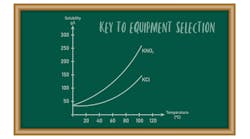A boss of mine regularly reminded me that making chemicals is fun. He would say this immediately after presenting me with a new production-line problem to solve. Yes, I enjoyed the challenge; eventually all was fine, if not fun. Difficulties with crystallization particularly come to mind. Crystallization seems a simple operation. You just cool the solution and out drops your product. We should be so lucky! Making a crystalline product must be one of the most complicated operations next to brain surgery. First, the crystals don’t like being out of their mother solvent unless given no alternative. Second, nucleation is a random event. Slight changes in their environment (temperature, impurities, etc.) will prompt fine crystals to return to the safety of the solvent. Third, often there are different crystal forms (habit, polymorph, etc.) that change or interfere with the final product’s characteristics. Fourth, particles can interact with surfaces to stick or agglomerate. They even can generate fine particles through secondary nucleation, making filtration a nightmare.
So, how do you prevent these bad things from happening? It all starts with the right data. Make obtaining the solubility curve your first step — and always remember there’s more to a solubility curve than just solubility. My March 2018 column “Get a Solubility Curve,” outlines the eight steps you should take to ensure the curve correctly represents your process. This is especially important when modifying an existing process because ingredients may have changed slightly over the years.
You should start by reviewing the solubility curve with a chemist and looking for the meta-stable-zone width. This will tell you the precision of process control necessary to prevent spontaneous nucleation. Process control includes not only temperature but also mother liquor strength and agitation. Those two factors often are overlooked. A high solute concentration at the beginning of a batch can allow an unstable polymorph to crystallize and grow. The problem may not show up in the crystallizer but, instead, downstream in separation, drying or material handling. You even may produce an amorphic compound rather than a crystal.
The type of crystallizer chosen for a compound can profoundly impact product quality and ease of manufacturing. Almost all products start out in a batch operation but going to large-scale production often requires a continuous process.
We like batch operations because the equipment can serve for many different products or steps in the production cycle. There’s more flexibility in generating supersaturation and nucleation, as well as a wide variety of particle size distributions. It’s hard to seed a continuous crystallizer. However, batch flexibility comes with a few problems, not to mention cost. The most common challenges include more-precise temperature control, prevention of segregation (poor agitation), scaling of heat-transfer surfaces, and secondary nucleation. On the plus side, batch crystallization successfully can handle difficult separations such as polymorphs and chiral chemicals through seeding or precise temperature control. You can control scaling of heat-transfer surfaces or fouling of the evaporation chamber by staying inside the meta-stable zone or providing low-solute-concentration wet/dry interfaces.
Continuous crystallizers seldom are designed for flexibility. Instead, they generally are tailored to produce one product shape, color and size so the downstream equipment can expect a consistent material once the process stabilizes. While you have a broad range of equipment choices, once a unit is installed there’s little room for change. Forced circulation devices have a low velocity region that separates the larger particles from the finer material. Growth occurs in the suspension, and nucleation usually happens by evaporation of the solute. Cooling can be used but often is a waste of energy.
Generally, forced circulation yields a wide particle-size distribution; Ostwald ripening can narrow this. Several types of crystallizers, e.g., draft-tube units, can give a narrower size distribution through fines destruction loops and elutriation channels. In addition, a host of solution crystallizers, such as the scrapped crystallizer, can produce a slurry or paste. It all depends on what you want as your final product. Solution crystallizers allow you to tailor the particle size for more-cost-efficient downstream processing such as solid/liquid separation.



